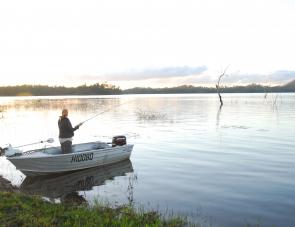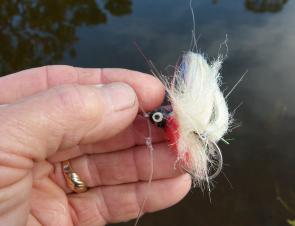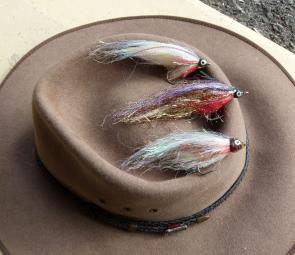This month I will delve deeper into the factors that can really assist in targeting barra on fly in shallow water (1m).
In any impoundment in winter, fish usually congregate at the back of bays where flats or shallow points are located. Most of our impoundments are full, so these places are easy to find. As long as a shallow bay is 1ºC or so above the surrounding areas it will attract warmth-seeking barra.
Clues to locating these warmer bays are often provided by Mother Nature. An angler can use an electric motor to travel over a likely area while watching the sounder to assess depth, but those tactics will also likely clear the area of fish. Barra in really shallow water are just as spooky in winter as summer. Drifting or poling the boat while assessing depth is a more productive option.
Knowing you are in the right bay will be confirmed by the sight of bony bream after about 10am or a few turtles coming up for a breath of air; turtles are cold-blooded critters and will always seek out a warmer bay if it’s there.
Sunlight and wind are the main factors influencing water temperature. A constant breeze blowing into a bay from the southeast, in lieu of the much cooler and more usual winter westerly winds, will see the constant wave movement plus sunlight cause that desirable warming, which draws barra like meat ants to a discarded chop bone.
Once a fishy looking area of shallow water is found and there has been the stealthiest possible approach used to assess the area, the next step is to tie up the boat and start casting. And this is the bit that requires dogged determination! There’s no percentage in casting for half an hour and then declaring an area fishless.
I caught a barra late last month that saw two hours of casting effort invested in the hook up. As I make a cast every two minutes on average there was certainly some determination involved but the fish I finally scored after a couple of near misses was 97cm. Certainly worth the effort.
Faith in the fish and confidence in your capability is required to keep that fly going out and then retrieved in slow – very slow – jerks and twitches until the line tightens and a flash of gold is seen.
If it takes two hours or more of casting to tag a fish, so be it. So long as the fly is being cast and retrieved in an enticing manner a fish will likely come along sooner or later and make it all worthwhile.
Keeping absolutely quiet is a huge advantage but while working the fly there are a few things to watch for that are guaranteed to cause both excitement and renewed casting effort.
The first indication that the grip on the rod handle should be tightened is a big fat boil, as a fish looks at a fly then rejects it. A boil, a whirlpool of displaced water, the tiniest tap followed by a big swirl; these are hints of big things to come.
If, however, another 20 minutes is put into casting and there’s been no hook up, I’d suggest changing the fly for another. If white has been the predominant colour change it for another colour altogether. Barra are notoriously finicky, talk to any lure angler and see how often that person changes lures.
Another really strong hint that action won’t be long in coming is when the fly comes back to the boat totally turned inside out after a strange sensation that the fly line has gone momentarily slack during the retrieve. Instead of the usual steady but gentle resistance from the fly line and big 3/0 or 4/0 fly as they are moving through the water, there’s a feeling that everything has been cut off at the rod tip!
What’s happened is that a fish has inhaled the fly, given it a crunch in the gill crushers (hence its total dishevelment) and then exhaled. The curious loss of tension on the fly line is caused by the fly moving forward as it exits the barra’s mouth. I’ve seen it happen on many occasions.
There are a few clues worth keeping in mind when playing a barra that has taken a fly.
Firstly, there will be no need to set the hook. If your flies are tied on Gamakatsu SL2S hooks, as mine usually are, the fly will be well imbedded in the jaw or mouth and the impact from the fish will see the hook taking a good hold.
Barra love to jump, which can cause the gill rakers to get into play on the last section of leader. I always use 40lb Siglon FC100 for my 40cm final bite off trace and seldom ever lose fish, so jumping is OUT.
To prevent a fish from jumping keep the rod down as low as possible and exert maximum side strain by using the rod as a long lever. Butt action is what this is about with the rod tip not used to any great extent until the fish has been beaten and is on its way to the net. Initially, the reel’s drag should be really tight with the fingers also exerting pressure on the line when a fish is heading for cover.
Then, if the fish is in more open water, particularly in the closing stages of a fight, the drag can be released somewhat to ensure that any last second lunges don’t pop the leader or tear the fly out at this critical stage of proceedings.
Last, but not least. Once you locate that goldmine of a winter hot spot lock it in for future use. And, of course, as spring looms with weather hotting up that same area will be a mighty good kick off spot for a summer campaign on barra!
Reads: 2744
Denise Kampe looks pretty happy with her late August barra from Lake Monduran.

A water temperature of 16ºC didn’t stop Denise from taking this late winter barra.

With a water depth of around 1m out from the boat, there’s every chance of a hook up in this situation.

How close was that? A fly turned inside out means that a barra has inhaled, crushed, and exhaled it without being hooked.

Big flies are for barra, with colour variety essential.




